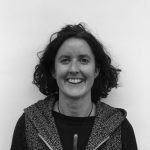Karen Alim
Faculty for Physics | TU München
The Alim lab investigates how organisms grow to form a desired structure and pattern. The aim is to identify mechanisms of development by studying the physical principles underlying the formation and adaptation of biological organisms. The Alim lab uses a broad range of tools in theoretical biophysics like analytical and numerical methods from mechanics, fluid dynamics, statistical physics and non-linear dynamics to investigate the mechanics of plant growth and the fluid dynamics enabling the slime mould Physarum polycephalum to adapt its network-like body to its environment.
Thomas Greb
Center for Organismal studies | Heidelberg University
The Greb lab uses lateral plant growth as an example to reveal principles of growth and cell fate regulation in multicellular organisms. Lateral growth of plant shoots and roots is based on the tissue-forming properties of a group of stem cells called the cambium, the activity of which leads to the production of secondary vascular tissue. Considering its function as a stem cell niche that is essential for the constant production of new tissues in a highly differentiated cellular environment the cambium represents an ideal model for addressing questions concerning the regulation of cell identity and how growth processes are aligned with endogenous requirements. Focusing on this emerging research area, the Greb lab applies a set of unique tools (repertoire of novel marker lines, imaging, mutant collections, experimental access to individual tissues and cell types, modelling, visualization of cell mechanics) to characterize this highly underexplored process.
Fred Hamprecht
Center for scientific computing | Heidelberg University
The Hamprecht lab develops, applies and deploys image analysis methods based on machine learning for the life sciences. The goal is to let the user indicate, in the simplest possible fashion, what parts of an image or what temporal patterns in a video are of interest. The computer should learn to emulate the human expert from such minimal annotation, and then process automatically very large or very many images. There is a trade-off between the required level of detail of the human expert annotations on the one side and the computational effort required to learn from annotations on the other side. The work of the Hamprecht lab lies at the interface of machine learning, image processing and optimisation. The lab further develops easy-to-use software to allow broad dissemination of the most successful methods.
Angela Hay
MPI for plant breeding | Cologne
The Hay lab investigates the genetic basis of phenotypic differences between related plant species and examines the evolutionary processes underlying such differences. The group uses parallel genetics in Cardamine hirsuta and its relative Arabidopsis thaliana and focuses on the mechanism of pod shatter for seed dispersal, which is explosive in C. hirsuta, causing seeds to disperse up to several meters away, whereas it is non-explosive in A. thaliana. The Hay lab aims to understand how differences in fruit morphology evolved to provide these two species with dramatically different seed dispersal strategies. Furthermore, the group follows a combined biological and computational approach to conceptualise how the interplay of genetic and mechanical regulation in the developing fruit is translated into explosive pod shatter.
Anna Kreshuk
EMBL | Heidelberg
The Kreshuk lab develops machine learning-based methods and tools for automatic segmentation, classification and analysis of biological images. On the research side, the group is particularly interested in large-scale segmentation problems such as segmentation of cells or nuclei in tissue volumes. Here, their focus is on the methods to exploit prior information based on biological domain knowledge, in an explicit formulation or learned from data, to improve segmentation performance and reduce the amount of training data even in the presence of biological variability. On the software development side, Kreshuk lab has taken over the development of the ilastik software which originated in the Hamprecht lab back in 2010. On the interface between research and software development, they investigate strategies for fine-tuning of convolutional neural networks from sparse user annotations. Besides, they develop and maintain tools for distributed segmentation of multi-Terabyte volumes.
Jan Lohmann
Center for Organismal studies | Heidelberg University
The Lohmann lab investigates the regulatory mechanisms underlying shoot meristem activity in changing environments using an integrated approach based on molecular, biochemical, genomic, as well as imaging strategies. The group has made important contributions to our understanding of stem cell induction and maintenance by the WUSCHEL homeodomain transcription factor and its downstream targets, among them components of hormone signalling pathways with long range activities. Consequently, one of the core interests of the lab is to decipher the communication between developing organs at the periphery and the stem cell population in the centre of the meristem, and the role of morphogenetic parameters for shoot apical meristem function at the cellular scale. The Lohmann lab has recently uncovered that modulation of the abiotic environment in the form of day-length or ambient temperature has a substantial influence on stem cell activity and meristem layout, which can be uncoupled, now opening new avenues to study how form and function of the shoot apical meristem are linked at the mechanistic level.
Alexis Maizel (Coordinator)
Center for Organismal studies | Heidelberg University
The Maizel lab is interested in the cellular and molecular bases of plant developmental plasticity. The goal is to understand how, at the cell scale, plants are able to adapt their post-embryonic development to their environment. The Maizel lab uses the root system of Arabidopsis thaliana, which continuously forms new lateral roots, a highly plastic process. The Maizel lab studies the morphodynamics of lateral root formation, in particular the role played by physical constraints (cell and tissue mechanics as well as environmental parameters) on shaping this organ and ensuring its robust development. The group combines live imaging using light sheet microscopy, molecular genetics and computational and systems analysis.
Kay Schneitz (deputy coordinator)
Technical University | Munich
The Schneitz lab applies a combination of molecular genetics, biochemistry and advanced microscopy to the study of the cellular and molecular mechanisms controlling organ shape in plants. The lab uses the integuments of the Arabidopsis thaliana ovule, the major female reproductive organ, to address the role of inter-cellular signalling during tissue morphogenesis. The asymmetric development of the outer integument imposes a characteristic curved shape on the ovule. The Schneitz lab has identified a signalling pathway regulating the initiation and outgrowth of the integuments. The lab has also characterised a gene that controls planar growth of the integuments by attenuating a central component of the adaxial-abaxial (dorso-ventral) polarity system. Currently, the Schneitz lab is identifying novel components in these signalling pathways and focuses on the possible role of cell and tissue mechanics in the generation of the characteristic shape of the outer integument.
Richard Smith
The John Innes Centre | Norwich, UK
The Smith lab uses mathematical and computer simulation techniques to develop cellular-level simulation models of plant tissues. These models involve a biochemical aspect, genes, proteins, and hormones, combined with growing, changing geometry as cells divide and tissues grow. Of particular interest to the Smith lab is how genes control physical properties of cells resulting in growth, and how the resulting change in geometry and physical forces feeds back on signalling and gene regulation. In collaboration with experimentalists the lab develops methods to quantify cellular geometry and growth, as well as the mechanical properties of plant tissues. This information is used to inform biophysically-based simulation models, where genes directly influence the mechanical properties of cells resulting in growth. The mechanical models allow the simulation of the feedback of stresses and strains on signalling cascades and gene expression, and allow to explore the role of mechanical forces in morphogenesis.
Miltos Tsiantis
MPI for plant breeding | Cologne
The Tsiantis lab focuses on understanding how biological forms are produced, maintained and how they diversify. The lab makes use of the two plant models Arabidopsis thaliana and Cardamine hirsuta to elucidate how different genotypes are translated into different organismal morphologies through the process of morphogenesis. In particular, the lab studies the formation of different leaf morphologies in these two species. In addition, they work towards conceptualising how the balance of conservation versus divergence in gene regulatory networks directing development yields different morphologies during evolution. The Tsiantis lab uses genetics, advanced biological imaging and computational modelling.









